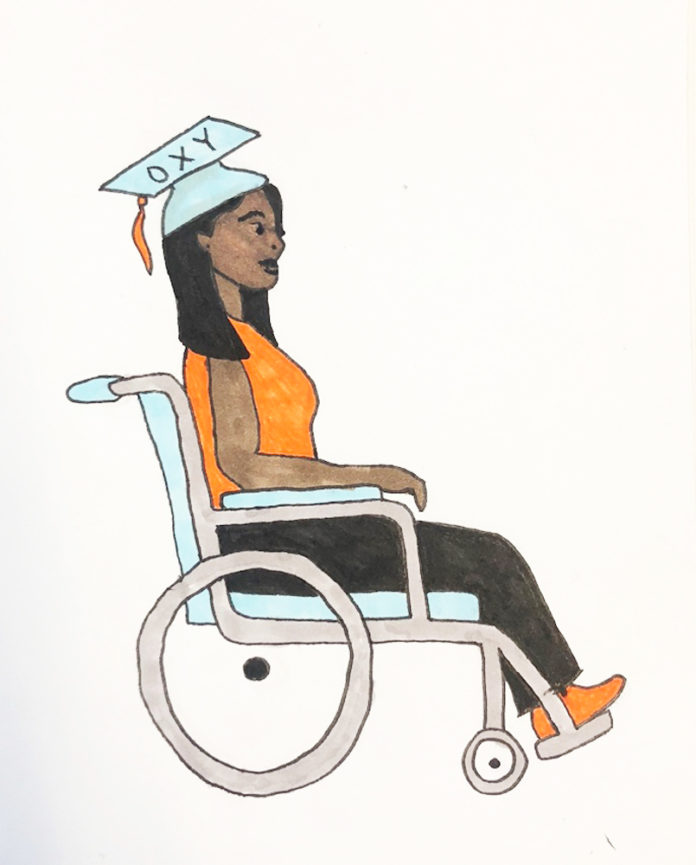The Occidental administration released an interactive map of campus March 27. The map includes a wide array of features, such as the ability to see the sites of future buildings, locate all the Obama monuments and highlight handicap-accessible routes across campus. However, the last feature — handicap accessibility — indicates one of campus’ greatest issues: the lack of safe and adequate accessibility to upper campus.
Presently, people can access upper campus by road or by stairway. However, each route presents its own challenges to making Occidental’s campus a truly safe and accessible place for all, especially those with disabilities.
Occidental’s roads pose one significant hurdle to upper campus accessibility. Gilman Road, which leads up to the Greek Bowl, lacks a sidewalk or walkway, forcing students to share the road with traffic and literally walk in the street. The same holds true for Coons Road by Berkus Hall, which also leads to upper campus. Both of these roads also run up steep inclines, making accessibility even more of an issue for students with disabilities.
Stairways located by Stearns and Pauley Halls provide some remedy to the issue by allowing pedestrians to cut across campus without having to defer to the roads. However, those stairways do not make the roads any safer or address handicap accessibility. Furthermore, the Stearns stairway leads to yet another steep road without walkways.
The closure of Sycamore Glen further exacerbates the school’s accessibility issues. The glen features an accessible walkway that links lower and upper campuses, but it remains out of use due to construction at the Anderson Center for Environmental Sciences. The school plans to re-open the glen Fall 2020, but until then, students have to settle for other, less accessible methods of getting to upper campus. Even when Sycamore Glen reopens, its ramp cannot act as the sole accessible method of getting to upper campus — it leads to residential halls such as Braun and Stewie, but it leaves the Greek Bowl and Keck Theater inaccessible.
One way to get around the issue of campus accessibility is to call Campus Safety for rides. According to Occidental’s website, Campus Safety can be called 24/7 for assistance. However, relying on Campus Safety as the sole provider of safe transit poses its own set of problems: students may not feel comfortable calling Campus Safety or they might not have their phone on them. Furthermore, calling Campus Safety for a ride anytime you need to move around campus is an unrealistic demand for students and robs them of a sense of agency. For example, a trip to the Cooler from Norris would require a student to call Campus Safety for a ride — which would then be followed by another ride back up the hill.
Occidental’s lack of accessibility also reflects poorly on the school, especially when you compare it to how other schools address issues of accessibility. For example, Cornell University — notorious for its hills — operates a service known as CU Lift that provides students with transportation in and around campus. Cornell also has a system called Red Runner for staff and faculty with disabilities. Similarly, the University of California, Berkeley operates a service that provides transportation for students, staff and faculty with disabilities called The Loop. The lack of such services at Occidental suggests that the administration does not care for the needs of community members with disabilities and runs counter to the school’s mission statement of providing an education for “a gifted and diverse group.”
To address the issue of campus accessibility, the Occidental administration must develop new routes across campus. For example, the schools could add walkways to roads such as Gilman and Coons that allow for safe use by all students. Admittedly, this would require time and investment on the part of the administration, but the addition would provide numerous benefits — it would ensure student safety by moving us off of the road, and it would give students with disabilities the means to get to upper campus independently.
At the very least, the school could create a shuttle service that provides transportation to students with disabilities, similar to those at Cornell or a proposed system at Tufts University. This can and should be a separate service from Campus Safety, dedicated to giving students with disabilities the means to move across campus in a safe and convenient manner. Implementing this system would be straightforward — it could utilize the school’s current fleet of golf carts and employ authorized student drivers. The service would improve access to upper campus while leaving Campus Safety to their own obligations. Furthermore, students may feel more comfortable using a service staffed by their peers.
Creating a more accessible campus should be a priority for the school. The needs of Occidental’s community — especially its students with disabilities — outweigh any financial inconvenience that the necessary changes may pose; infrastructural and quality of life investments can only improve Occidental and its image. Drastic changes do not have to come immediately, but we do need them eventually. Creating a new shuttle service while planning and implementing new walkways would go a long way in solving the campus’ accessibility crisis and making Occidental a welcoming place for all.
Pablo Nukaya-Petralia is a junior politics and art and art history double major. He can be reached at pnukayapetra@oxy.edu.
![]()



































